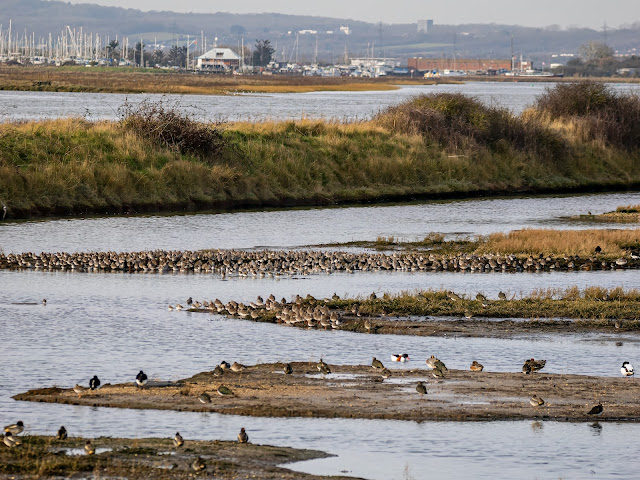This morning I had a visit
to EWT Two Tree Island, a site that I can easily
reach from home by public transport.
EWT Two Tree Island is situated adjacent to
the internationally protected Thames Estuary and it is a winter refuge for a
huge diversity and abundance of winter wildfowl (most notably Dark-bellied
Brent Geese) and waders plus a wide range of breeding and migrant
birds during the rest of the year.
EWT Two Tree Island was reclaimed from the
sea in the 18th century when a seawall was built around the saltmarsh and
it was originally used for farming. It is now managed as a nature reserve.
Approximately 4 miles
of trails, which are a mixture of gravel and grass paths, provide access
through the grasslands and scrub areas. At the end of the western section of
the reserve is a bird hide which overlooks a lagoon which provides a valuable
habitat for roosting and breeding water birds. The eastern section is part
of Leigh National Nature Reserve where the saltmarsh is one of the best
surviving in the Thames Estuary.
I arrived at EWT Two Tree Island at 10:30 a.m. after walking down
to the bridge over Leigh Creek from Leigh-on-Sea railway station.
I initially walked down
to the slipway overlooking the marshes and Hadleigh Ray before then walking along
the seawall to the westernmost point of the island and "Monty's Lookout", the hide overlooking the lagoon.
I timed my visit so
that I was in the hide for more than an hour before high tide at 12:30 p.m. when the lagoon normally becomes packed with roosting waders.
As I arrived at "Monty's Lookout",
there were already large numbers of birds on the lagoon with even more arriving
all the time. It eventually calmed down with birds either roosting or feeding
but around midday the huge flock of Knot erupted into flight and
eventually disappeared over the seawall to relocate elsewhere. However, large
numbers of other wader species and ducks remained. There was no sign of any predatory
raptor and no other apparent reason for the Knot taking flight from
their high tide roost.
It proved to be a very
productive 3 hour visit to EWT Two Tree Island with 10 species of waders recorded, most notably
the huge flock of Knot but surprisingly no Avocets.
Apart from the large flocks
of waders and ducks, my return walk to the reserve exit produced a very
confiding female Kestrel which I was able to photograph plus exceptional
views of a Barn Owl hunting over the scrub adjacent to the road near Leigh-on-Sea
railway station. Unfortunately, I had already packed my binoculars, telescope
and camera away in readiness to get a train back to Basildon so the Barn Owl
was just a straightforward, albeit amazing, observation.
The highlights from
my visit, including the walk from Leigh-on-Sea railway station to the entrance to EWT Two Tree Island were as follows: Knot (at least 1000), Common
Redshank (at least 200), Dunlin (at least 100), Black-tailed
Godwit (c.50), Lapwing (c.50), Oystercatcher (c.20), Curlew
(c.10), Grey Plover (c.10), Common Snipe (4), Turnstone (1),
Teal (at least 200), Wigeon (at least 200), Shelduck (c.30),
Mallard (4), Brent Goose (at least 100), Little Grebe (2),
Moorhen (3), Coot (2), Cormorant (3), Little Egret (2),
Common Gull (c.20), Barn Owl (1), Kestrel (1), Skylark
(1), Meadow Pipit (4)
Here are some photos from my visit ....
Photo: Knot
Photo: Knot
Photo: Knot

Photo: Knot
Photo: Knot
Photo: Knot
Photo: Knot
Photo: Knot
Photo: Knot

Photo: Knot
Photo: Knot
Photo: Curlew
Photo: Curlew

Photo: Curlew
Photo: Grey Plover

Photo: Common Snipe
Photo: male and female Wigeon
Photo: male Wigeon
Photo: male Teal

Photo: male and female Teal
Photo: Dark-bellied Brent Geese
Photo: female Kestrel
Photo: female Kestrel
Love nature .... act now
Restore and rewild our natural world
Please help save and enhance our laws that protect our environment and wildlife
💚🦆 🦉🦋🐝🦊🦡🌼 🌳💚
Stay safe, stay well, stay strong, stay connected with nature






































